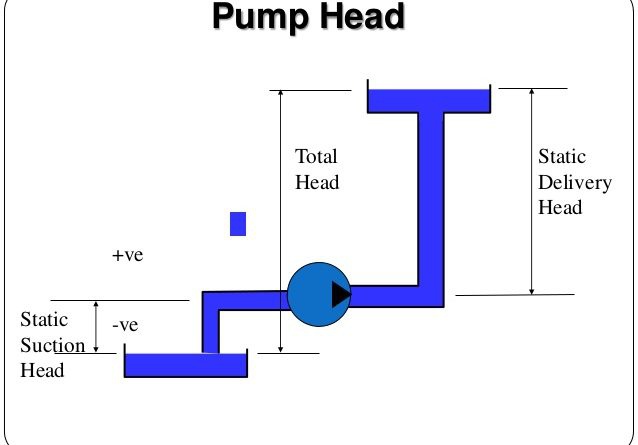The static head corresponding to any specific pressure is dependent upon the weight of the liquid according to the following formula:
| Eq. (4) |
Newtonian liquids have specific gravities typically ranging from 0.5 (light, like light hydrocarbons) to 1.8 (heavy, like concentrated sulfuric acid). Water is a benchmark, having a specific gravity of 1.0.
This formula helps in converting pump gauge pressures to head for reading the pump curves.
The various head terms are discussed below.
Note: The Subscripts ‘s’ refers to suction conditions and ‘d’ refers to discharge conditions.
● Static Suction Head, hS
● Static Discharge Head, hd
● Friction Head, hf
● Vapor pressure Head, hvp
● Pressure Head, hp
● Velocity Head, hv
● Total Suction Head HS
● Total Discharge Head Hd
● Total Differential Head HT
● Net Positive Suction Head Required NPSHr
● Net Positive Suction Head Available NPSHa
Static Suction Head (hs)
Head resulting from elevation of the liquid relative to the pump center line. If the liquid level is above pump centerline, hS is positive. If the liquid level is below pump centerline, hS is negative. Negative hS condition is commonly denoted as a “suction lift” condition.
Static Discharge Head, (hd)
It is the vertical distance in feet between the pump centerline and the point of free discharge or the surface of the liquid in the discharge tank.
Friction Head (hf)
The head required to overcome the resistance to flow in the pipe and fittings. It is dependent upon the size, condition and type of pipe, number and type of pipefittings, flow rate, and nature of the liquid.
Vapor Pressure Head (hvp)
Vapor pressure is the pressure at which a liquid and its vapor co-exist in equilibrium at a given temperature. The vapor pressure of liquid can be obtained from vapor pressure tables. When the vapor pressure is converted to head, it is referred to as vapor pressure head, hvp. The value of hvp of a liquid increases with the rising temperature and in effect, opposes the pressure on the liquid surface, the positive force that tends to cause liquid flow into the pump suction i.e. it reduces the suction pressure head.
Pressure Head (hp)
Pressure Head must be considered when a pumping system either begins or terminates in a tank which is under some pressure other than atmospheric. The pressure in such a tank must first be converted to feet of liquid. Denoted as hp, pressure head refers to absolute pressure on the surface of the liquid reservoir supplying the pump suction, converted to feet of head. If the system is open, hp equals atmospheric pressure head.
Velocity Head (hv)
Refers to the energy of a liquid as a result of its motion at some velocity ‘v’. It is the equivalent head in feet through which the water would have to fall to acquire the same velocity, or in other words, the head necessary to accelerate the water. The velocity head is usually insignificant and can be ignored in most high head systems. However, it can be a large factor and must be considered in low head systems.
Total Suction Head (Hs)
The suction reservoir pressure head (hpS) plus the static suction head (hS) plus the velocity head at the pump suction flange (hVS) minus the friction head in the suction line (hfS).
| HS= hpS + hS + hvS – hfS | Eq. (5) |
The total suction head is the reading of the gauge on the suction flange, converted to feet of liquid.
Total Discharge Head (Hd)
The discharge reservoir pressure head (hpd) plus static discharge head (hd) plus the velocity head at the pump discharge flange (hvd) plus the total friction head in the discharge line (hfd).
| Hd= hpd + hd + hvd + hfd | Eq. (6) |
The total discharge head is the reading of a gauge at the discharge flange, converted to feet of liquid.
Total Differential Head (HT)
It is the total discharge head minus the total suction head or
| HT = Hd + HS (with a suction lift) | Eq. (7) |
| HT = Hd – HS (with a suction head) |
NPSH
When discussing centrifugal pumps, the two most important head terms are NPSHr and NPSHa.
Net Positive Suction Head Required, NPSHr
NPSH is one of the most widely used and least understood terms associated with pumps. Understanding the significance of NPSH is very much essential during installation as well as operation of the pumps.
Pumps Can Only Pump Liquids, Not Vapor
The satisfactory operation of a pump requires that vaporization of the liquid being pumped does not occur at any condition of operation. This is so desired because when a liquid vaporizes its volume increases very much. For example, 1 ft3 of water at room temperature becomes 1700 ft3 of vapor at the same temperature. This makes it clear that if we are to pump a fluid effectively, it must be kept always in the liquid form.
Rise in temperature and fall in pressure induces vaporization
The vaporization begins when the vapor pressure of the liquid at the operating temperature equals the external system pressure, which, in an open system is always equal to atmospheric pressure. Any decrease in external pressure or rise in operating temperature can induce vaporization and the pump stops pumping. Thus, the pump always needs to have a sufficient amount of suction head present to prevent this vaporization at the lowest pressure point in the pump.
NPSH as a measure to prevent liquid vaporization
The manufacturer usually tests the pump with water at different capacities, created by throttling the suction side. When the first signs of vaporization induced cavitation occur, the suction pressure is noted (the term cavitation is discussed in detail later). This pressure is converted into the head. This head number is published on the pump curve and is referred as the “net positive suction head required (NPSHr) or sometimes in short as the NPSH. Thus the Net Positive Suction Head (NPSH) is the total head at the suction flange of the pump less the vapor pressure converted to fluid column height of the liquid.
NPSHr is a function of pump design
NPSH required is a function of the pump design and is determined based on actual pump test by the vendor. As the liquid passes from the pump suction to the eye of the impeller, the velocity increases and the pressure decreases. There are also pressure losses due to shock and turbulence as the liquid strikes the impeller. The centrifugal force of the impeller vanes further increases the velocity and decreases the pressure of the liquid. The NPSH required is the positive head in feet absolute required at the pump suction to overcome these pressure drops in the pump and maintain the majority of the liquid above its vapor pressure.
The NPSH is always positive since it is expressed in terms of absolute fluid column height. The term “Net” refers to the actual pressure head at the pump suction flange and not the static suction head.
NPSHr increases as capacity increases
The NPSH required varies with speed and capacity within any particular pump. The NPSH required increase as the capacity is increasing because the velocity of the liquid is increasing, and as anytime the velocity of a liquid goes up, the pressure or head comes down. Pump manufacturer’s curves normally provide this information. The NPSH is independent of the fluid density as are all head terms.
Note:It is to be noted that the net positive suction head required (NPSHr) number shown on the pump curves is for fresh water at 20°C and not for the fluid or combinations of fluids being pumped.
Net Positive Suction Head Available, NPSHa
NPSHa is a function of system design
Net Positive Suction Head Available is a function of the system in which the pump operates. It is the excess pressure of the liquid in feet absolute over its vapor pressure as it arrives at the pump suction, to be sure that the pump selected does not cavitate. It is calculated based on system or process conditions.
NPSHa calculation
The formula for calculating the NPSHa is stated below:
| NPSHas = hps + hs – hvps + hfswhere:hps = Head pressure or the barometric pressure of the vessel converted to headhs = Static suction head or the vertical distance between the eye of the first stage impeller centerline and the suction liquid levelhvps = Vapor pressure head or the vapor pressure of the liquid at its maximum pumping temperature converted to headhfs = Friction head or friction and entrance pressure losses on the suction side converted to head | Eq. (9) |
It is important to correct for the specific gravity of the liquid and to convert all terms to units of “feetabsolute” in using the formula.
Any discussion of NPSH or cavitation is only concerned about the suction side of the pump. There is almost always plenty of pressure on the discharge side of the pump to prevent the fluid from vaporizing.
NPSHa in a Nutshell
In a nutshell, NPSH available is defined as:
| NPSHa = Pressure head + Static head – Vapor pressure head of your product – Friction head loss in the piping, valves and fittings.where all terms are in absolute feed of head. | Eq. (10) |
In an existing system, the NPSHa can also be approximated by a gauge on the pump suction using the formula:
| NPSHa = hpS – hvpS ± hgS + hvSwhere:hpS = Barometric pressure in feet absolutehvpS = Vapor pressure of the liquid at maximum pumping temperature, in feet absolutehgS = Gauge reading at the pump suction expressed in feet (plus if above atmospheric, minus if below atmospheric) corrected to the pump centerlinehvS = Velocity head in the suction pipe at the gauge connection, expressed in feet | Eq. (11) |
Significance of NPSHr and NPSHa
The NPSH available must always be greater than the NPSH required for the pump to operate properly. It is normal practice to have at least 2 to 3 feet of extra NPSH available at the suction flange to avoid any problems at the duty point.


